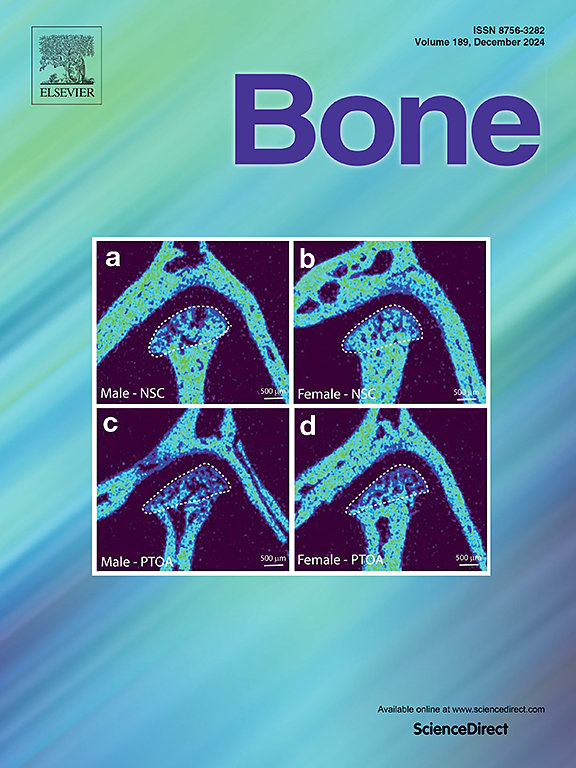Small and porous ossicles, with flat stapes footplate and incudal fractures in the oim mouse model of osteogenesis imperfecta
IF 3.6
2区 医学
Q2 ENDOCRINOLOGY & METABOLISM
引用次数: 0
Abstract
Hearing loss affects approximately 70% of individuals with osteogenesis imperfecta (OI), a genetic connective tissue disorder characterized by bone fragility and deformities. No effective treatments exist for OI hearing loss, and its etiology is unknown limiting the development of new targeted therapies. This work investigates the impact of OI type I collagen mutations on the ossicle bone properties in the homozygous oim mouse model of severe OI, which is known to exhibit hearing loss. The morphology and porosity of the ossicles of 14-week-old oim and wild-type mice were analyzed using high-resolution synchrotron radiation microtomography. Additionally, the collagen fibers structure, bone tissue composition and mechanical properties were evaluated through second harmonic generation microscopy, Raman spectroscopy, and nanoindentation. The results demonstrated that oim ossicles are small, highly porous with an elevated lacunar number density, a flat stapes footplate and a small malleal processus brevis. One-in-two oim ossicles had incudomalleal joint abnormalities, exhibiting either a localized fracture in the incus head or a joint space widening. No differences were observed in collagen fibers structure, bone tissue composition and mechanical properties. These findings suggest that bone fractures observed in the oim incudes may contribute to their reported hearing loss. However, the underlying mechanism for these fractures' development remains to be investigated, as they do not appear to result from changes in bone tissue properties (collagen fibers organization, tissue composition or mechanical properties). Instead, they may be associated with joint space widening, and possibly altered ossicle chain kinematics.
成骨不全症小鼠模型中的小而多孔的小听骨、扁平的镫骨、底板和包括骨折
听力损失影响大约70%的成骨不全症(OI)患者,成骨不全症是一种遗传性结缔组织疾病,其特征是骨骼脆弱和畸形。对于成骨不全听力损失没有有效的治疗方法,其病因不明限制了新的靶向治疗的发展。本研究研究了I型成骨不全胶原蛋白突变对严重成骨不全小鼠纯合子模型(已知表现为听力损失)听骨特性的影响。采用高分辨率同步辐射显微断层扫描技术分析了14周龄野生型和野生型小鼠小骨的形态和孔隙度。此外,通过二次谐波显微镜、拉曼光谱和纳米压痕技术对胶原纤维结构、骨组织组成和力学性能进行了评估。结果表明,小听骨体积小,多孔性强,腔隙数密度高,镫骨足板平坦,短柄柄小。1 / 2的小听骨有incincominal关节异常,表现为incincominal头局部骨折或关节间隙扩大。胶原纤维结构、骨组织组成和力学性能均无差异。这些发现表明,在研究对象中观察到的骨折可能与他们报告的听力损失有关。然而,这些骨折发生的潜在机制仍有待研究,因为它们似乎不是由骨组织特性(胶原纤维组织、组织成分或机械特性)的变化引起的。相反,它们可能与关节间隙变宽有关,并可能改变听骨链运动学。
本文章由计算机程序翻译,如有差异,请以英文原文为准。
求助全文
约1分钟内获得全文
求助全文
来源期刊

Bone
医学-内分泌学与代谢
CiteScore
8.90
自引率
4.90%
发文量
264
审稿时长
30 days
期刊介绍:
BONE is an interdisciplinary forum for the rapid publication of original articles and reviews on basic, translational, and clinical aspects of bone and mineral metabolism. The Journal also encourages submissions related to interactions of bone with other organ systems, including cartilage, endocrine, muscle, fat, neural, vascular, gastrointestinal, hematopoietic, and immune systems. Particular attention is placed on the application of experimental studies to clinical practice.
 求助内容:
求助内容: 应助结果提醒方式:
应助结果提醒方式:


